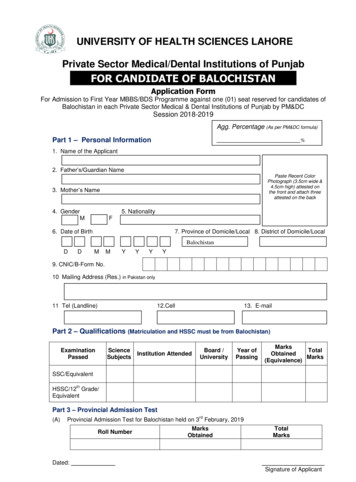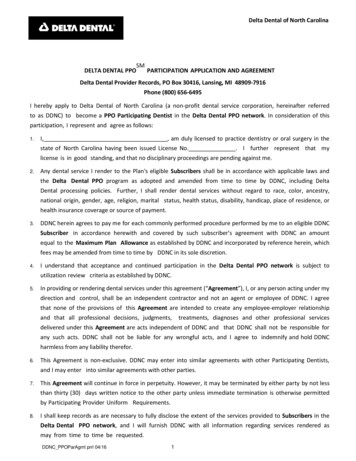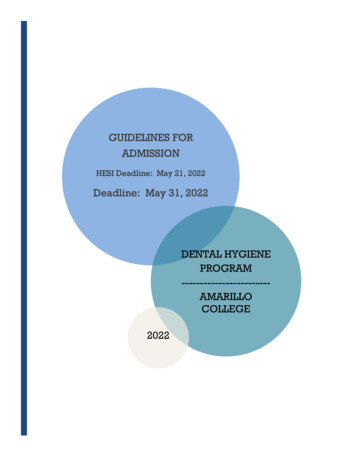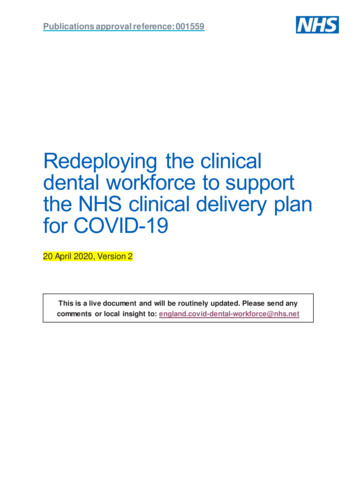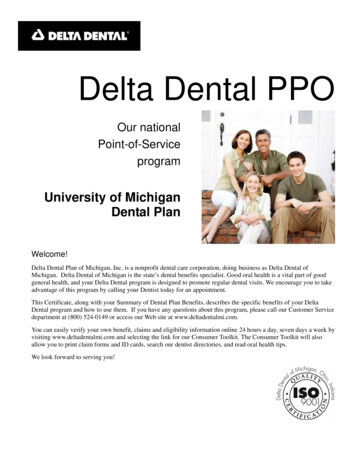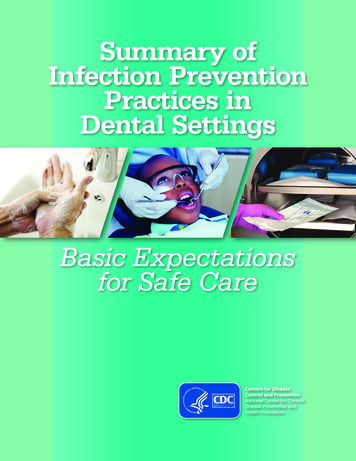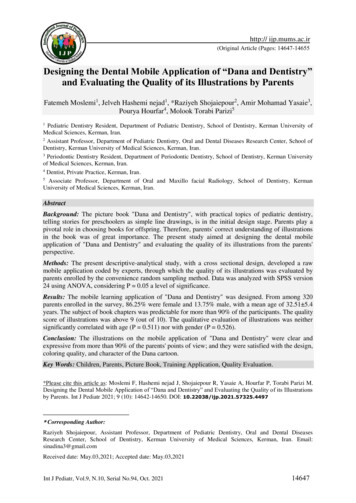
Transcription
http:// ijp.mums.ac.ir(Original Article (Pages: 14647-14655Designing the Dental Mobile Application of “Dana and Dentistry”and Evaluating the Quality of its Illustrations by ParentsFatemeh Moslemi1, Jelveh Hashemi nejad1, *Raziyeh Shojaiepour2, Amir Mohamad Yasaie3,Pourya Hourfar4, Molook Torabi Parizi511Pediatric Dentistry Resident, Department of Pediatric Dentistry, School of Dentistry, Kerman University ofMedical Sciences, Kerman, Iran.2Assistant Professor, Department of Pediatric Dentistry, Oral and Dental Diseases Research Center, School ofDentistry, Kerman University of Medical Sciences, Kerman, Iran.3Periodontic Dentistry Resident, Department of Periodontic Dentistry, School of Dentistry, Kerman Universityof Medical Sciences, Kerman, Iran.4Dentist, Private Practice, Kerman, Iran.5Associate Professor, Department of Oral and Maxillo facial Radiology, School of Dentistry, KermanUniversity of Medical Sciences, Kerman, Iran.AbstractBackground: The picture book "Dana and Dentistry", with practical topics of pediatric dentistry,telling stories for preschoolers as simple line drawings, is in the initial design stage. Parents play apivotal role in choosing books for offspring. Therefore, parents' correct understanding of illustrationsin the book was of great importance. The present study aimed at designing the dental mobileapplication of "Dana and Dentistry" and evaluating the quality of its illustrations from the parents'perspective.Methods: The present descriptive-analytical study, with a cross sectional design, developed a rawmobile application coded by experts, through which the quality of its illustrations was evaluated byparents enrolled by the convenience random sampling method. Data was analyzed with SPSS version24 using ANOVA, considering P 0.05 a level of significance.Results: The mobile learning application of "Dana and Dentistry" was designed. From among 320parents enrolled in the survey, 86.25% were female and 13.75% male, with a mean age of 32.51 5.4years. The subject of book chapters was predictable for more than 90% of the participants. The qualityscore of illustrations was above 9 (out of 10). The qualitative evaluation of illustrations was neithersignificantly correlated with age (P 0.511) nor with gender (P 0.526).Conclusion: The illustrations on the mobile application of "Dana and Dentistry" were clear andexpressive from more than 90% of the parents' points of view; and they were satisfied with the design,coloring quality, and character of the Dana cartoon.Key Words: Children, Parents, Picture Book, Training Application, Quality Evaluation.*Please cite this article as: Moslemi F, Hashemi nejad J, Shojaiepour R, Yasaie A, Hourfar P, Torabi Parizi M.Designing the Dental Mobile Application of “Dana and Dentistry” and Evaluating the Quality of its Illustrationsby Parents. Int J Pediatr 2021; 9 (10): 14642-14650. DOI: 10.22038/ijp.2021.57325.4497* Corresponding Author:Raziyeh Shojaiepour, Assistant Professor, Department of Pediatric Dentistry, Oral and Dental DiseasesResearch Center, School of Dentistry, Kerman University of Medical Sciences, Kerman, Iran. Email:sinadina3@gmail.comReceived date: May.03,2021; Accepted date: May.03,2021Int J Pediatr, Vol.9, N.10, Serial No.94, Oct. 202114647
Design and Evaluation of the Mobile Application, “Dana and Dentistry”1- INTRODUCTIONToday, wireless technology, especiallycell phones, is a revolution in educationand can be considered one of the mostimportant learning tools. Learning throughmobile applications increases ion activities, and enableslearning, regardless of time and distance(1). Due to the interest of users and theposition of mobile in the current society,the attitude towards mobile should beshifted from a decorative product to aneducational interface (2).Mobile health (m-Health)-i. e., the use ofmobile devices in medicine and publichealth practices, is rapidly expanding in ehealth and improves healthcare andmedical services. The m-Health isdesigned to promote healthcare andimprove services to healthcare providers(3). However, technology has extensivelyadvanced to motivate general and oralhealth surveillances. Modern technologyand software for oral health education arewidely available in dentistry (4).Parents play a decisive role in shaping thebehaviors and habits of offspring. Parentscan positively affect the health-relatedbehaviors of children (5). Parents'perspectives also influence supporting andencouraging children to maintain health(6). The parents play a role in diet,behavior, oral care activities, and receivingprofessional dental services in childrenaged five years and younger (7). Trainingand motivating parents to maintain oralhygiene and nutrition in their children canchange their behavior (8). Parents need thetraining to achieve ideal preventive carefor a healthy diet, good oral hygiene, andsupervision for dental health maintenancein their children. Oral health informationshould effectively be disseminated, furtherpractical recommendations provided, andaccess to dental care facilitated in order topromote (9) the knowledge and skills ofparents in caries etiology and reduction ofInt J Pediatr, Vol.9, N.10, Serial No.94, Oct. 2021bacterial distribution, brushing withfluoridetoothpaste,flossingandcontrolling child’s toothbrush behaviors,reducing the consumption of sugar, snacks,and the bottle, understanding dental cariesprocess, the role of fluoride in preventingcaries, the best time to go to the dentist,and their logic expectations (7). A costeffective way to reduce the risk ofchildhood caries is to brush twice a day;justified parents apply methods such asgroup games to promote their childrenbenefit from toothbrush advantages.Parents can use oral hygiene books forchildren to encourage them to thetoothbrush. Studies show no significantrelationship between the frequency ofbrushing and child age and that it is justthe result of parental efforts andinterventions at all ages of the child (10).The picture book "Dana and Dentistry",rounded up by a pediatric dentist, includes18 chapters and 131 schematic paintingsillustrated by a female painter for kids. Theillustrations are simple and storytelling tomake a lasting and broad effect on thetarget population, increase awareness ofdental science and its application in cariescontrol and prevention to empower them tomake a better choice and decide in the faceof dental diseases and injuries (11).Pictures of the stated book were presentedto preschool children and more than 60%of them showed an appropriateunderstanding regarding the pictures (12).Parents are the first teachers of offspring,and their correct understanding ofillustrations on the application is of greatimportance. Considering the closerelationship between parents and theiryoung children, parents play an importantrole in the process of selecting and readingbooks for them so in the present project,the quality of illustrations in the dentalhealth application of "Dana and Dentistry"was evaluated from the perspective of theusers- i.e., parents.14648
Moslemi et al.2- MATERIALS AND METHODS2-1. Designing the Dana and DentistryapplicationThe raw mobile application was codedby programming experts. The informationin the book "Dana and Dentistry" wasseparately entered into the raw format ofthe application in batches and designed asan Android application that could beinstalled on mobile phones.2-2. Evaluation of the qualityillustrations by the users (parents)of2-3. Study design and populationA total of 10 kindergartens were selectedfrom different areas of Kerman, Iran, usingthe cluster sampling method, and aftercoordination with their authorities, 320parents of preschoolers were selected bythe convenience sampling method andenrolled in the study after obtaininginformed consent. "Dana and Dentistry"dental health application was installed onusers' cellphones. Then, the quality ofillustrations in the book "Dana andDentistry" was evaluated using aresearcher-made electronic questionnaire,which its reliability and validity wereconfirmed earlier.any reason were reluctant to participate inthe study were excluded.2-5. Ethical considerationThe present descriptive-analytical studywas registered at Kerman University 2-6. Data AnalysisData were analyzed in SPSS version 24using ANOVA; P-values less than 0.05were considered significant.3-RESULTS3-1. Design and build of "Dana andDentistry" applicationThe application used the extensiblemarkup language (XML) in Java software,and it was compiled with Android Studiosoftware version 3.6 in order to build anAndroid application that can be installedon mobile phones. Fig. 1 shows the homepage of the application or the illustrationon the back cover of the book.The first part of the questionnaire includedthe demographic information of parentsand children (age and gender). In thesecond part, the parents were asked toguess the subject of each chapter afterseeing the illustrations in the book. In thethird part, the parents were asked about thequality of illustrations in every 18chapters.2-4. Inclusion and exclusion criteriaParents participating in this study had atleast one preschool child. They alsoneeded access to an android device inorder to be able to install the “Dana andDentistry”application.Furthermore,parents who were not capable of learninghow to work with the application or forInt J Pediatr, Vol.9, N.10, Serial No.94, Oct. 2021Fig. 1: The Home Page of "Dana andDentistry" Application14649
Design and Evaluation of the Mobile Application, “Dana and Dentistry”3-2. Evaluation of the quality ofillustrations on "Dana and Dentistry"applicationTotally, 86.25% of parents were femaleand 13.75% male, with a mean age of32.51 5.4 years, ranging from 25 to 45.The mean age of the children was 4.18 3.2 years, and 61.25% of them werefemale (Table 1).The results obtained from the parents'descriptive answers, including the numberand percentage of false and true answerson each chapter, are reported in Table 2.The results showed that illustrations oneach chapter were clear to more than 90%of the parents, and they could correctlyguess the subject of the chapter.Table-1: Demographic Information of the Study ParticipantsDemographicInformationParents’ genderChildren’s -2: Users’ responses for each chapter based on the illustrations on the bookChapters of the book "Dana and Dentistry"1. What are the tooth parts?2. What are the shapes of the crown and roots of the teeth?3. Does a deciduous tooth have nerves?4. Does deciduous tooth denervation damage permanent teeth?5. What are the side effects of deciduous tooth extraction?6. What is the space-maintainer?7. At what age do deciduous teeth grow?8. Are you aware of the growth of the first permanent molar?9. Do you know the number of deciduous teeth?10. What to do when multiple rows of teeth are formed?011. What is the most proper way to brush your children's teeth?12. Are you familiar with the fissure sealant technique?13. At what age is fluoride mouthwash advised?14. Do you know the cause of tooth decay?15. Do iron drops cause black discoloration of teeth?16. What to do if a tooth is knocked out?17. What to do if a dental crown is damaged?18. Do you know when the best time for the first dentist visit is?Fig. 2 shows the average quality score ofusers on book illustrations. Illustrations onall 18 chapters of the book "Dana andDentistry" were of high quality (scored 9)Int J Pediatr, Vol.9, N.10, Serial No.94, Oct. 2021Correct Answer(Percentage)308 .18)298(93.12)296(92.5)False Answer(Percentage)12 5.62)7(2.18)9(2.82)22(6.88)24(7.5)from the viewpoint of the parents, andillustrations on chapters 11, 12, 14, 16, 17,and 18 had the maximum quality (scored10).14650
Moslemi et al.Fig. 2: The users’ satisfaction mean scores (0-10) on the Chapters of the Book "Dana andDentistry"Table 3 shows that the qualitativeevaluation of the illustrations was neithersignificantly correlated with age (P 0.511) nor with gender (P 0.526). Inaddition, none of the variables of thechildren’s age (P 0.535) and gender (P 0.575) were significantly correlated withthe quality mean scores of the parentsevaluating the illustration.Table-3: The correlations between the users’ satisfaction mean scores and their Age andGenderVariableAgeGenderThe Quality Assessment Scores of the 20-Item Questionnaire, Based on a 10Point 10.2718 0.526Total3204- DISCUSSIONIn the present study, the mobile dentalhealth application of "Dana and Dentistry"Int J Pediatr, Vol.9, N.10, Serial No.94, Oct. 2021was designed for installation on Androidmobile phones. This dental healthapplication can effectively and widely be14651
Design and Evaluation of the Mobile Application, “Dana and Dentistry”used for different purposes of education,communication, support, and motivationamong the patients. Borhani et al., showedthat the use of mobile phone applicationsfor distance nursing could reduce theserum levels of glycosylated hemoglobinin patients with type 2 diabetes (13).Ghazisaeedi et al., showed that more than82% of the users were satisfied with anapplication designed for caring forchildren with cerebral palsy and met theirinformation needs (14). Safdari et al.,showed that the users were satisfied withthe application designed for tuberculosis(15). Alizadeh et al., also indicated thatmore than 78% of the users approved theeffects of educational information on theapplication (16). Technology is widelyavailable in oral hygiene (3) and hasadvantages in pediatric dentistry for thechild and his parents. Children today aremore familiar with technology; and dentalhealth applications can help in a widerange of areas, including familiarizingthem with the dentist's office environment,dispelling fears and misconceptions aboutdentistry, and promoting oral hygiene.Aljafari et al., reported that a game-basedoral health education could be as satisfyingand effective as one-to-one education inimproving knowledge in high-riskchildren. Even the education could lead topositive dietary changes in some families(17). Duijster et al., reported that mediatools were attractive to young patientsundergoing long-term dental treatments,such as orthodontics, and improved theircompliance. It is difficult to maintain andpromote oral health of children for a longtime (6). Huebner et al., revealed that evenif the level of parental education is low,good oral hygiene improves when childrenare supported by technologies designed forthis purpose. Their study also showed thathome-based oral health programs arealmost accepted by all young patients (18).Zotti et al., similarly, showed the role ofdevices and applications for oral healthmanagement in promoting the cooperationInt J Pediatr, Vol.9, N.10, Serial No.94, Oct. 2021of young patients (19). They indicated thatthe family has a prominent role in thecontrol and prevention of diseases, andimproving parental awareness is a positivestep to promote self-care behaviors andrelieve diseases (8). Nowadays, technologyhas extensively advanced to motivateindividuals in general and oral health.Modern technology and applications fororal health education are widely availablein dentistry (4). In a study, Sara L Nolen etal., designed and evaluated a mobileapplication to promote oral health andprevent early childhood caries (ECC) andreported that using a mobile application forthis purpose potentially provides theopportunitytocommunicateandpotentially help overcome the challengesof managing oral diseases such as ECC.(20) In addition to the above, parents playa key role in reporting their child'scooperation and can be a source forordering more applicable media to supportoral health. This concept is more practicalin private offices, where the dentist, youngpatients, and their parents have a closercommunication, compared to the largerhospitals (4). The application oftechnology seems desirable in healthpromotion. The scientific principles shouldbe followed in the design of suchapplications, and necessary care has to betaken in the application of evidence-basedcontent. Tiffany et al., identified andevaluated a number of Android or IOSapplications of oral health for adults. Theyreported that although many applicationsare available, their quality is generallypoor (21). A key point in this regard is theavailability of technology tools used toincrease and maintain compliance overtime to prevent a lack of interest,especially in young patients. Technologydevelopment can challenge the users withongoing competitions and goals bybuilding new, well-designed applicationswith regular updates, an aspect that is ofgreat importance to young patients (4).14652
Moslemi et al.The results of the present study showedthat each chapter's illustrations were clearto more than 90% of parents and theycould correctly guess the subjects. Parentswere also very satisfied with theapplication; hence, it can be widely used inpromoting the quality of oral health inchildren. Francesca et al., showed in astudy that the knowledge and socioeconomic status of parents often affectchildren's oral health and motivation toregularly visit the dentist. They examinedthe effect of an oral health application onpatients aged 4-7 years and the relationshipbetween parental education and children'soral health. Accordingly, 100 patients wererandomly assigned to the case and controlgroups. All patients and parents weretrained before intervention in oral hygienepractices as chair-side. The case group wasgiven an auxiliary application for oralhealth practices. A 12-month follow-upshowed that the case group had better oralhealth and cooperation than controls. Itseems that parental education affectschildren's oral health (4). Therefore, therole of families in determining the generaland oral health of children is undeniable.Parents have always faced challenges incaring for offspring teeth. In many cases,they do not have enough information totake appropriate measures to maintainchildren's oral health, and in other cases,they need to strengthen their motivationfor this purpose. It seems that applicationdesign can be a step in overcoming manybarriers to children's oral health. However,obtaining such results requires furtherresearch to evaluate the knowledge andpractice of the application visitors.4-1. Study LimitationsThe main limitations of the study includedtheimpossibilityofface-to-faceinterviewing the users due to socialdistancing guidelines for the COVID-10pandemic and the lack of access of someparents to Android phones.Int J Pediatr, Vol.9, N.10, Serial No.94, Oct. 20215- CONCLUSION"Dana and Dentistry" application wasdesigned for installation on Androidphones. More than 90% of the parentscorrectly guessed the subject of eachchapter of the application, only based onillustrations; and their quality assessmentscores on illustrations were above 9 (out of10). There was no significant correlationbetween their responses and their age andgender, as well as the age and gender oftheir children.6- CONFLICT OF INTERESTNone.7- REFERENCES1. Sarani H, Aayati M. The Impact OfMobile Phone Using (Sms) On LearningEnglish Vocabulary And The StudentsAttitude. Curriculum Planning Knowledge& Research in Educational Sciences. 2014;11(13):48-60.2. Lee R-G, Hsiao C-C, Chen K-C, Liu MH. An Intelligent Diabetes Mobile CareSystemwithAlertMechanism.Biomedical Engineering: Applications,Basis and Communications. 2005;17(04):186-92.3. Free C, Phillips G, Watson L, Galli L,Felix L, Edwards P, Et Al. TheEffectivenessofMobile-HealthTechnologies to Improve Health CareService Delivery Processes: A SystematicReview and Meta-Analysis. Plos Med.2013; 10(1):E1001363.4. Francesca Zotti, Angelo Pietrobelli,LucianoMalchiodi, Pier-FrancescoNocini, Massimo Albanese . Apps for oralhygiene in children 4 to 7 years: Fun andeffectiveness. J Clin Exp Dent. 2019 Sep;11(9): e795–e801.5. Peggy Pui-Lai Or, Patricia Tai-YinChing, Joanne Wai-Yee Chung . Can FluLike Absenteeism in Kindergartens BeReduced Through Hand Hygiene TrainingforBothParentsandTheir14653
Design and Evaluation of the Mobile Application, “Dana and Dentistry”Kindergarteners?J Prim Care CommunityHealth.2020Jan-Dec;11:2150132719901209.6. Denise Duijster, Maddelon de JongLenters, Erik Verrips, Cor van Loveren.Establishing oral health promotingbehaviours in children – parents’ views onbarriers, facilitators and professionalsupport: a qualitative study. BMC OralHealth. 2015; 15: 157.7. Kristin S. Hoeft, Judith C. Barker,Stephen Shiboski, Estela Pantoja Guzman,Robert A. Hiatt. Effectiveness evaluationof Contra Caries Oral Health EducationProgram for improving Spanish-speakingparents’ preventive oral health knowledgeand behaviors for their young children.Community Dent Oral Epidemiol. 2016Dec; 44(6): 564–576.8. Corissa P. Chang, Judith C. Barker,Kristin S. Hoeft, Claudia Guerra, Lisa H.Chung, Nancy J. Burke . Importance ofcontent and format of oral healthinstruction to low-income Mexicanimmigrant parents: A qualitative study.Pediatr Dent. 2018 Jan 1; 40(1): 30–36.9. Rahul Naidu, June Nunn, Maarit Forde .Oral healthcare of preschool children inTrinidad: a qualitative study of parents andcaregivers. BMC Oral Health. 2012; 12:27.10. CE Huebner , P Milgrom . Evaluationof a parent-designed programme tosupport tooth brushing of infants andyoung children. Int J Dent Hyg. 2015 Feb;13(1): 65–73.11. Moslemi F, Hasheminejad J,Shojaeipour R,Abdolahi M,Horri A.Designing the Picture Book Entitled "Dana and Dentistry" Based on PediatricDentistry Text Books in Order to Increasethe Knowledge of Preschool Childrenabout Dentistry. International Journal ofPediatrics, 2021. 9(10). 14625-14633.12. Hasheminejad J, Moslemi F,Shojaeipour R, Yasaie AM, Sarayani A,Int J Pediatr, Vol.9, N.10, Serial No.94, Oct. 2021Torabi Parizi M Evaluation of the Qualityof the Pictorial Book ‘Dana and Dentistry’from Preschool Children’s viewpoint.International Journal of Pediatrics, 2021.9(10). 14634-14641.13. Borhani F, Ranjbar H, Abbaszadeh A,Abazari F, Ranjbar A. The Effect ofTelenursing (Cell Phone Software) onA1C Hemoglobin In Patients With Type 2Diabetes Mellitus. 2013.14. Ghazisaeedi M, Sheikhtaheri A,Dalvand H, Safari A. Design andEvaluation of an Applied EducationalSmartphone-BasedProgramforCaregivers of Children With CerebralPalsy. Journal of Clinical Research inParamedical Sciences. 2015; 4(2).15. Safdari R, Hasan Nejadasl H, RostamNiakan-Kalhori S, Nikmanesh B. DesignAnd Evaluation Of Mobile Based SelfManagement System For Tuberculosis.Journal of Payavard Salamat. 2018;12(3):230-8.16. Alizadeh I, Gorouhi Ma, AghaeiAfshar A, Hayati R, Mirr I. Satisfaction OfMobile Users With Mobile Application"Identification, Prevention, And Control OfBed Bugs": Designing And DevelopingMobile Health Application. Journal ofHealth and Biomedical Informatics. 2019;6(1):24-31.17. Aljafari A, Gallagher JE, Hosey MT.Can oral health education be delivered tohigh-caries-risk children and their parentsusing a computer game? A randomisedcontrolled trial. Int J Paediatr Dent 2017Nov; 27(6):476-48518. Huebner CE, Riedy CA. Behavioraldeterminants of brushing young children’steeth: implications for anticipatoryguidance. Pediatr Dent. 2010; 32:48-55.19. Zotti F, Dalessandri D, Salgarello S,Piancino M, Bonetti S, Visconti L, et al.Usefulness of an app in improving oralhygienecomplianceinadolescent14654
Moslemi et al.orthodontic patients. Angle Orthod. 2016;86:101-10720. Nolen SL, Giblin-Scanlon LJ, BoydLD, Rainchuso L. Development andtesting of a smartphone applicationprototype for oral health promotion. J DentHyg. 2018; 92(2):6 –1421. Tiffany B, Blasi P, Catz SL, McClureJB. Mobile Apps for Oral HealthPromotion: Content Review and HeuristicUsability Analysis. JMIR mHealth uHealth2018 Sep 04; 6(9):e11432Int J Pediatr, Vol.9, N.10, Serial No.94, Oct. 202114655
Associate Professor, Department of Oral and Maxillo facial Radiology, School of Dentistry, Kerman University of Medical Sciences, Kerman, Iran. Abstract Background: The picture book "Dana and Dentistry", with practical topics of pediatric dentistry, telling stories for preschoolers as simple line drawings, is in the initial design stage.





